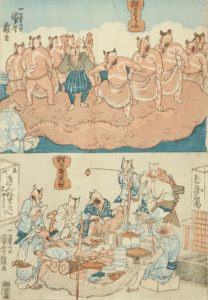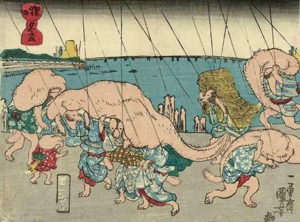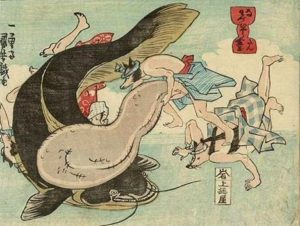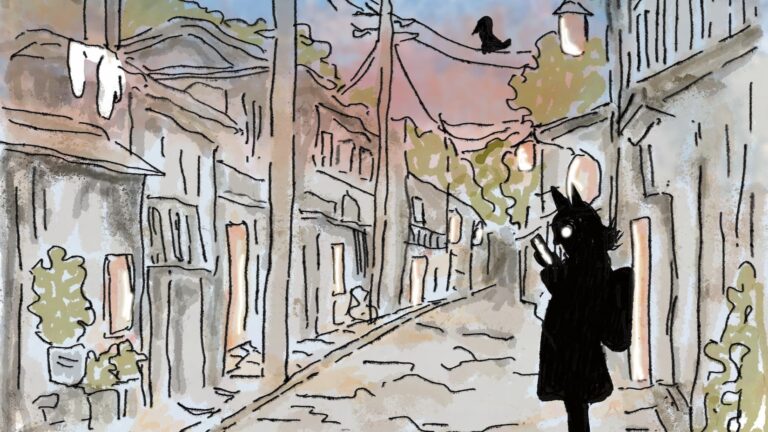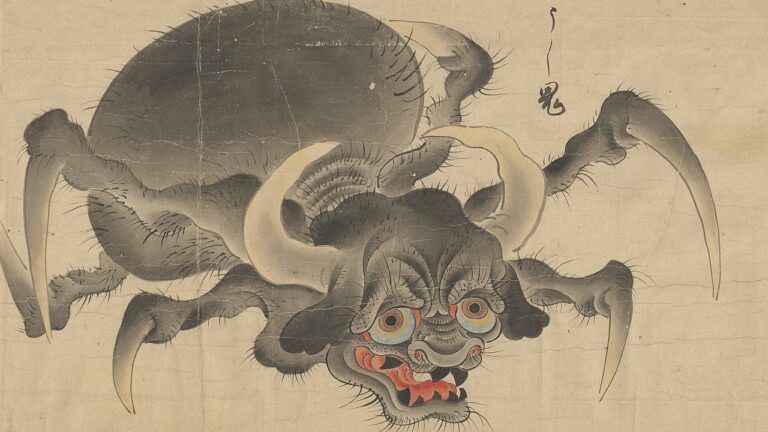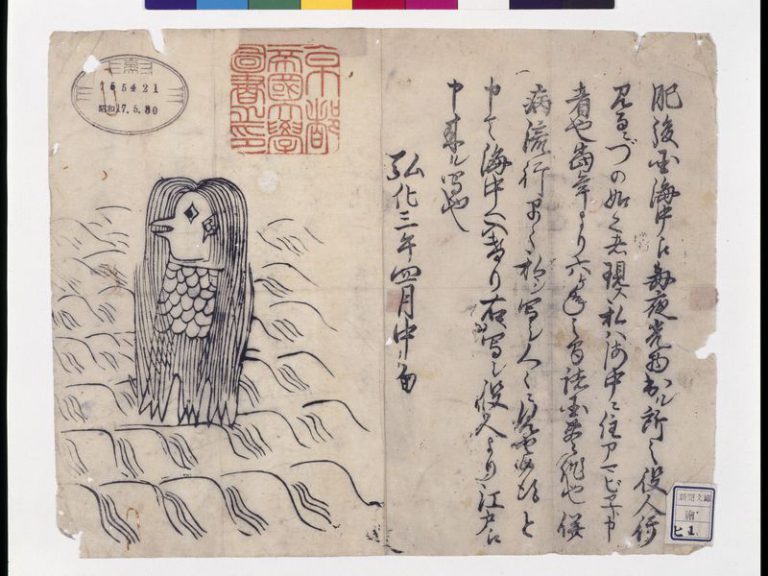Tanuki are those adorable, magical animals you find all through Japanese history. They’re in folktales, art, legend, and even in modern day manga and anime. On today’s episode I’ll talk about these furry, shape-shifting critters, touching on all the well known facts as well as some more obscure ones.
Here are some of Utagawa Kuniyoshi’s silly testicle heavy images of tanuki doing various creative things.
The Story of Bunbuku Chagama
Mukashi mukashi, long, long ago, a kindly, poor man was trekking through the woods one day when he came across a tanuki caught in a hunter’s trap. Poor creature! He immediately freed the animal and then watched it scamper off, hoping it would be okay. A short while later, in the middle of his path was a splendid cast iron tea pot, a chagama. Strange. No one was around. It was a magnificent thing, but left out here it would rust. So he took it home. Then something else weird happened, he found he had a strange affection for this inanimate object and wanted to keep it.
But it was much too lavish for the likes of him. The man was nothing if not poor, kind, AND self aware. He decided to gift it to the head monk of the local temple.
The monk was impressed, such an ornate heavy iron kettle. He decided to use it right away. He asked the poor, kind, self aware man to please stay for a cup of tea. The man said yes and thought it really was his lucky day.
The monk then filled the chagama with water and placed it on a bed of hot coals while he prepared the tea leaves. But almost at once the kettle began to sweat, then tremble, then scream.
What? The two men rushed over to see what was wrong, when suddenly out popped a tail, a head, and four legs. A tanuki!
Well, half a tanuki. The body was still an iron tea kettle. The tanuki/kettle leapt off the smoking coals and howled in pain as it rolled around on the floor.
The poor man begged the monk to allow him to nurse the creature back to health. The monk said, fine, but I’ll do better than that. You can have it back.
The poor man then cared for the tanuki/kettle, learning, as you and I have already figured out, that it was the tanuki he had freed from the hunter’s trap. It had wanted to repay the man’s kindness, but had not thought through the fact that if it transformed itself into an iron tea kettle, there was a very good chance it might be placed over a fire. Over the next few weeks, the creature got better, but was still stuck in the half tanuki, half teakettle form. But the poor, kind, self aware man was also non judgemental. He didn’t care. He just enjoyed having some company.
Once the tanuki/kettle was back to its energetic self the man admitted that he was really poor. He barely had enough food for himself. He apologized. Meh, no problem, said the tanuki/kettle. My idea of repaying your kindness by transforming into a chagama wasn’t that bright. But now I have an better idea. How about we set up a stage and perform. I’m a great dancer and can even walk on a tightrope.
It was a great idea.
The two worked up some exciting routines which were so popular, people from other towns and cities traveled to see them. The man and the tanuki/kettle became best friends earning loads of money, enough to live comfortably and to help others, both human and animal and human/animal if they ever came along.
The end.
There are many versions of that story, called Bunbuku Chagama (分福茶釜) in Japanese. That is an extremely abbreviated and extremely MY twist on the old tale. You can find other versions online, if you’d like to see what they sound like. It might be called “The Accomplished and Lucky Tea Kettle” or the “Wonderful Tea Kettle”.
For new patrons and wannabe patrons, there’s another one of my versions, longer than this one, up on the page if you look through past Bedtime Stories, I think it’s number 35.
Anyway, I told that story to introduce you to today’s magical critter. You guessed it, the tanuki.
What is a Tanuki?
There is so much to say about the tanuki. It’s one of the reasons I haven’t done an episode on them before. Another reason I haven’t addressed these furry creatures is that I feel it’s one of the better known beasties in Japan — both the magical and real versions. I like to introduce you all to the more obscure parts of the culture, so I wasn’t sure I could find anything new on this fluffy little guy. But I was wrong. I dug up some stuff I never knew and have never heard mentioned before in English, so this should be fun.
But first, for those not in the know, a tanuki — sometimes translated as raccoon dog — does look something like a raccoon, but it’s not, it’s more dog than raccoon, actually. They do have a mask, thought, and some combination of grey, black, brown, silvery fur, long tail, pointy nose. Quite cute. It’s not entirely unheard of to find very badly taxidermied ones displayed in a restaurant, inn, or even sold at a thrift shop. That one looked rough. I’ve seen a handful of those in my time here, as well as real ones, prowling around at night. I’ve never seen a wild fox, by the way.
Speaking of foxes, Tanuki, like the fox, or kitsune (狐), are both a real animal and a mythical creature. Or are the real animals also magical, just hiding it?
Different Names for Tanuki
Anyway, today I’m going to talk about the bake danuki (化け狸), bake meaning to change or transform. The bake danuki is a kind of youkai (妖怪) and can be found all through Japanese literature and art.
They have also gone by the names mujina (狢) and mami (猯 or 魔魅). Although, these two words could be referring to different, but similar looking animals, like the hakubishin (ハクビシン) a kind of civet.
In the Kansai (western) area of Japan they were sometimes called mameda, bean tanuki, while up north especially in the Iwate and Aomori areas they were referred to as kusai.
Listeners who speak Japanese might be giggling right now, because the word kusai sound suspiciously like the word to stink, or reek. Well, you’d be right.
There was something called kusaitsuki (クサイ憑き), being possessed by a kusai. When you were taken over by a tanuki, you became very lax with your hygiene and refused to bathe. As you can imagine, your smell became unbearable. Hence, you must surely be possessed by a kusai because you stink.
In order to rid yourself of this tanuki possession, you had to drink ohaguro (お歯黒). Ohaguro is the iron, tea, and vinegar paste that was used by women back in the day to paint their teeth black. It was also quite smelly. Somehow this smelly thing removed the other smelly thing, and the tanuki or kusai would leave your body.
First Mentioned in Nihon Shoki
The tanuki has been around forever and was written about way back in the Nihon Shoki, a text that came out in the 600s. There a little poem that says in the second month, the tanuki came out in Mutsunokuni (陸奥国), which is up in north-eastern Japan, where, the poem continues, they turned into humans and sang songs. Isn’t that lovely?
Mischievous, Drunken Shape-Shifters
That’s a nice segue into what our mischievous varmints can do. I mean besides possessing someone and preventing them from bathing, that is. Well, they can shape shift for one, and they’re quite adept at it. They do it by making cute ninja-looking hand mudras or placing a leaf on their head and poof!, they’re a person, or another animal, or sheet of cloth or even a teakettle as we saw in the story earlier. While foxes tend to turn into alluring women to lead you into temptation, tanuki become monks to play pranks on you.
Tanuki may be tricksters, but they’re not malicious really. They just enjoy a good joke at your expense. They carry their own container of sake around because they enjoy drinking. If they happen to run out of booze, they might buy some from you, but after they’re staggered off, you’ll notice the money you were paid is really just a handful of leaves.
Tanuki Thump Their Bellies
Tanuki also have big round bellies that they enjoy thumping on, playing a little tunes.
If you remember back in episode 35, Nanafushigi, Seven Mysterious Things, I talked about the Edo Nana Fushigi, Seven Strange Occurrences in Edo. One of them was the Tanuki Bayashi (狸囃子). When at night you’d hear some raucous festival music, drums, flute, follow it, thinking it’s some celebration, only to learn it was a tanuki or several tanuki leading you astray.
But despite all that, tanuki are also considered lucky.
Tanuki Giant Testicles
Now for the part of tanuki lore that everyone just loves to talk and giggle about, their boy parts. Seriously. Whenever you see depictions of them, or sculptures you find in gardens and out front of restaurants all over Japan, in ukiyo-e, or manga and anime, it’s hard not to notice their elephantine testicles.
Yes, they may be silly and outrageous, near obscene to some, they are also lucky and useful. I’ll put some of the more lively ukiyo-e prints up on the Uncanny Japan website, so you see all the amazing things they can do with their ridiculously endowed scrotum. For example, they can use them for a hat, a blanket, a net, a boat, or how about painting a face on them and dressing them in a nice kimono to pass them off as a person. I kid you not.
And I remember just loving how cool everyone here is with it. Children even have a rhyme they sing about how they swing back and forth even though there is no wind. And everyone knows the song.
Why The Giant Testicles?
Why you ask? Why? Well, it seems goldsmiths would place gold nuggets between tanuki pelts to hammer out gold leaf. I’m probably wrong but perhaps the word association goes something like this, you think of tanuki, you think of gold, those golden nuggets are veritable gold balls, kin tama (金玉), in Japanese. But, oh, dear, kintama, is also the Japanese word for testicles.
Tanuki Sayings
Okay, I’ll end today with a couple of tanuki sayings.
The first one is tanuki neiri, (狸寝入り). To sleep like a tanuki. Which when I was a child, my grandmother in Mississippi would say ‘playing possum’, or pretending your asleep. Which is kind of the same thing. Different animal. But close. Tanuki neiri, to fake sleeping.
The second is toranu tanuki no kawa zanyou (捕らぬ狸の皮算用) Basically, someone who counts or calculates their tanuki pelts before their caught. Yep, you guessed, it like counting your eggs before they’re hatched. Toranu tanuki no kawa zanyou.
And last, Kitsune nana bake, tanuki ya bake (狐七化け、狸八化け). Literally, foxes can change form seven times, tanuki can transform eight. It’s not literal, of course. It just means that tanuki are more skilled at shape shifting that even foxes. Kitsune nana bake, tanuki ya bake.
Ending
So there you have it, the tanuki. Furry, dog-raccoon animal, walking around on two legs, a bottle of sake in one hand, and IOU in the other. They’ve been around for hundreds of years, creating mischief, playing hypnotic tunes on their fat bellies, and being creative with their enormous scrotum. And if they sound familiar, you’re right. There all over Ghibli’s movie Pom Poko and in Animal Crossing where you’ll find Tom Nook. Tom Nook, Ta-nu-ki. Clever. And then there’s also Mario’s flying tanooki suit.
I will leave you here today. Remember to be kind to animals and people and strange objects you find in your path. Because they might just be a tanuki in disguise, either trying to repay your kindness or wanting to trick you by pawning off a pawful of bills, that turn into leaves later. Also, it’s probably not a good idea to accept any hats, blankets, or nets they might offer you. And whatever you do don’t get into that boat or touch any friend they happen to introduce you to. Eyu.
Thank you all for listening to today’s show, thank you especially to my patrons who make the show possible. I will talk to you in two weeks.
Bye bye!
Credits
Intro and outro music by Julyan Ray Matsuura.
Lively Classical Piano Waltz by MusicLFiles
Link: https://filmmusic.io/song/7167-lively-classical-piano-waltz
License: https://filmmusic.io/standard-license
Dixi Dance by Frank Schröter
Link: https://filmmusic.io/song/7063-dixi-dance
License: https://filmmusic.io/standard-license

